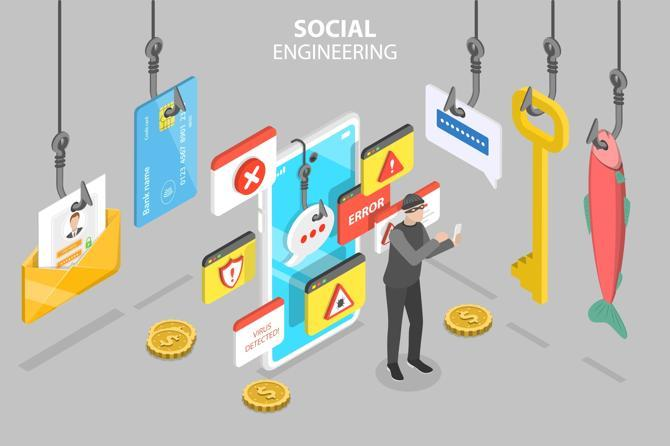 Threat Intelligence
Threat IntelligenceSocial Engineering: Why Humans Are the Weakest Link
August 15, 2025 • 7 min read
Hackers don't just exploit systems, they exploit people. Learn the psychology behind social engineering.
Despite advanced technical security measures, humans remain the most vulnerable point in any security system. Social engineering attacks manipulate human psychology rather than exploiting technical vulnerabilities, making them particularly dangerous and difficult to defend against.
Understanding Social Engineering
Social engineering is the art of manipulating people into performing actions or divulging confidential information. It preys on natural human tendencies like trust, curiosity, and the desire to be helpful.
Common Social Engineering Techniques
1. Pretexting
Creating a fabricated scenario to engage a target and extract information.
2. Phishing
Mass-scale attacks via email pretending to be from legitimate sources.
3. Spear Phishing
Highly targeted phishing attacks using personalized information.
4. Baiting
Offering something enticing to lure victims into a trap.
5. Quid Pro Quo
Offering a benefit in exchange for information or access.
6. Tailgating
Gaining physical access by following authorized personnel.
7. Vishing
Voice phishing using phone calls to extract information.
Psychological Principles Exploited
1. Authority
People tend to comply with requests from perceived authority figures.
2. Social Proof
The tendency to follow actions of others in uncertain situations.
3. Likability
People are more likely to comply with requests from people they like.
4. Scarcity
Creating urgency through limited time offers or exclusive opportunities.
5. Reciprocity
The feeling of obligation to return favors.
6. Consistency
The desire to act consistently with previous actions or statements.
Real-World Social Engineering Examples
- Tech support scams convincing victims to install remote access software
- Fake HR emails requesting password updates or personal information
- Impersonation of executives authorizing fraudulent wire transfers
- Fake delivery notifications containing malicious links
- Romance scams building emotional connections for financial exploitation
Advanced Social Engineering Tactics
1. OSINT Gathering
Using open-source intelligence to research targets thoroughly.
2. Digital Footprint Analysis
Studying social media and online presence for attack material.
3. Psychological Profiling
Creating detailed profiles of targets based on available data.
4. Multi-Channel Attacks
Combining email, phone, and social media for increased credibility.
5. Long-Term Operations
Building relationships over time for major attacks.
Defense Strategies
1. Security Awareness Training
- Regular training sessions with realistic scenarios
- Phishing simulation exercises
- Social engineering recognition workshops
- Continuous reinforcement of security principles
2. Technical Controls
- Multi-factor authentication implementation
- Email filtering and security gateways
- Web filtering and content blocking
- Access control and privilege management
3. Policies and Procedures
- Clear guidelines for handling sensitive requests
- Verification protocols for unusual transactions
- Incident reporting procedures
- Physical security measures
4. Organizational Culture
- Promoting security-conscious behavior
- Encouraging questioning of unusual requests
- Creating open communication channels
- Rewarding security vigilance
Detection and Response
1. Recognition Training
Teaching employees to identify social engineering attempts through:
- Unusual urgency or pressure
- Requests for sensitive information
- Mismatched communication styles
- Suspicious sender details
2. Verification Protocols
Establishing procedures for verifying:
- Unusual financial transactions
- Password change requests
- Access permission modifications
- Sensitive data transfers
3. Incident Response
- Clear reporting channels for suspected social engineering
- Rapid response procedures for confirmed incidents
- Communication protocols for alerting other potential targets
- Post-incident analysis and lessons learned
Industry-Specific Risks
Healthcare:
- Patient data theft through impersonation
- Medical identity fraud schemes
- Pharmaceutical diversion scams
Finance:
- Account takeover through customer manipulation
- Investment fraud using social proof
- Executive impersonation for wire transfers
Education:
- Student record theft through phishing
- Financial aid fraud schemes
- Research data theft attempts
Government:
- Credential theft for system access
- Sensitive information extraction
- Influence operations targeting officials
Emerging Trends in 2025
1. AI-Enhanced Social Engineering
- Personalized phishing at scale using machine learning
- Deepfake audio and video for impersonation
- Automated social media profiling and targeting
2. Hybrid Attacks
Combining social engineering with technical exploits for maximum impact.
3. Supply Chain Targeting
Using social engineering to compromise vendors and partners.
4. Remote Work Exploitation
Leveraging distributed workforce vulnerabilities.
Psychological Defense Techniques
1. Critical Thinking
Encouraging skepticism and verification of unusual requests.
2. Emotional Regulation
Training to recognize and manage emotional manipulation.
3. Situational Awareness
Developing awareness of context and potential threats.
4. Stress Management
Teaching techniques to maintain composure under pressure.
Measuring Defense Effectiveness
- Phishing test success rates
- Social engineering incident reports
- Security awareness assessment results
- Employee feedback and surveys
- Incident response performance metrics
Future Outlook
- Increasing sophistication of social engineering tactics
- Greater use of AI and automation in attacks
- More targeted and personalized approaches
- Integration with other attack vectors
- Evolving defense strategies and technologies
Remember: Technology alone cannot protect against social engineering. The most effective defense combines technical controls with comprehensive security awareness and a culture of vigilance.
By understanding human psychology and maintaining healthy skepticism, individuals and organizations can significantly reduce their vulnerability to social engineering attacks.